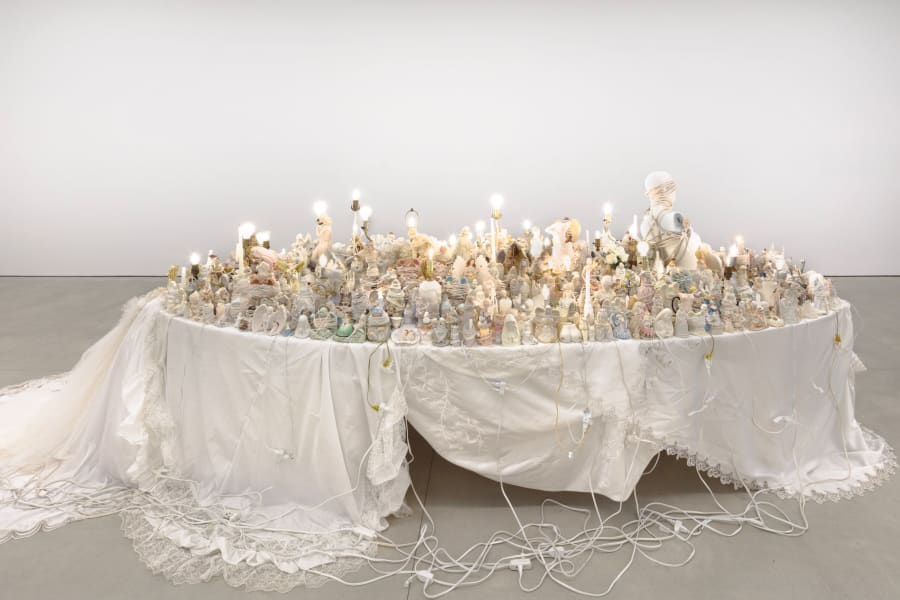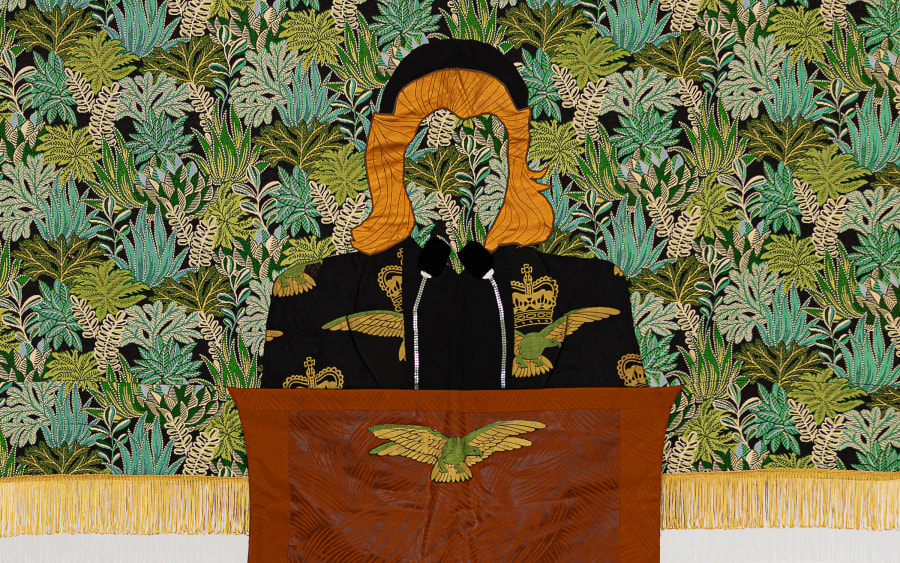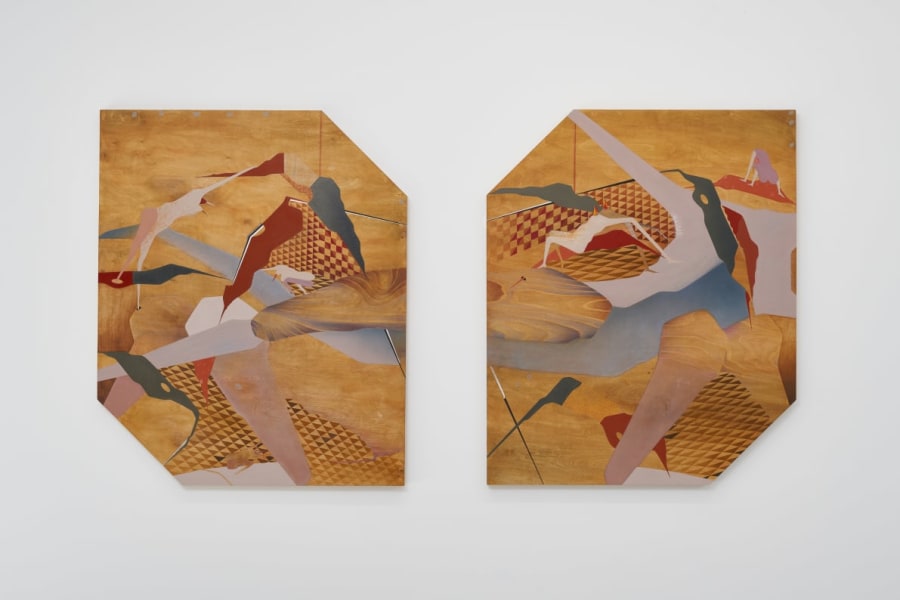駐紐約藝術家Jeremy Couillard原本是一名高中西班牙文教師,但在課堂之外,他投入大量時間創作複雜精細的漫畫和墨水畫。後來,他進入哥倫比亞大學攻讀藝術碩士,專心學習繪畫。但他很快感到厭倦:「我發現自己花在螢幕前的時間比在現實中的時間還多,因此科技話題越來越吸引我。甚至在畫畫時,我也大多是盯著電腦螢幕。」
因此,Couillard自學了程式設計,並開始嘗試動畫和3D遊戲創作工具虛幻引擎(Unreal Engine)。如今,他以創作敘事荒誕且帶有超現實主義風格的遊戲而聞名,比如《Escape from Lavender Island》(2023)。這款遊戲也在他目前於麻省理工學院李斯特視覺藝術中心(MIT List Visual Arts Center)舉辦的個展中佔據核心位置。觀眾可以坐在豆袋沙發上,化身遊戲主角Zede Aksis。這個綠色的雙足生物在監獄牢房中醒來,發現自己的反烏托邦城市夢境變成了現實。玩家的任務是逃離這個霓虹閃爍的恐怖都市。在逃亡中,他們追隨愛慕的物件,為舞蹈駐足,甚至可以戴上向路人噴射藥物的面具。Couillard談到這款帶有達達主義色彩的遊戲時說:「它關乎在城市中作為人類的生存體驗。遊戲很荒謬,但也的確非常悲涼。我想通過這款遊戲捕捉生存在當今社會的狀態。」
此次展覽還展示了一部隱隱透著詭秘氣息的視頻裝置,鏡頭掃過「Lavender Island」(薰衣草島)上奇異社區,伴隨著城市居民的旁白。不遠處,數碼繪製的木質花朵沿著地面綻放,牆上是幾幅色彩斑斕的畫作,猶如從遊戲中直接擷取的畫面。牆上還掛著一件滑稽的超大號螢光黃衛衣,上面印著「Depression」(抑鬱)。
展覽詼諧地批判了科技在社會中造成的疏離與隔閡。Couillard表示:「這種現象令人沮喪,但也讓人啼笑皆非,因為我們正在構建一個幾乎無人嚮往的科技世界,卻仍然義無反顧地向前推進。這個遊戲叫做《Escape from Lavender Island》(逃離薰衣草島),但在某種意義上,我們無法逃離現代生活。無論是福是禍,我們註定相伴。但我相信這終究是件好事,只要我們學會和彼此相處。」
‘Sometimes I feel like I have to thank my younger self, because I made three pivotal projects in a very short period of time. I launched Bitchcoin in 2015. Then I did a project called Stock Performance in which I day-traded to intentionally move the stocks’ performance lines and then painted the lines on canvases in a performance at 303 Gallery in January 2016. That summer I then filmed Cloud of Petals, a 16 mm short film showing 16 workers as they photograph 100,000 individual rose petals. The film was exhibited in 2017, and the massive dataset they were compiling was used to develop an artificial intelligence algorithm that can generate new unique petals forever. Bitchcoin was about use value and exchange value, both as an artwork and as a financial mechanism, because it wasn’t a performance; it was real. Same thing with Stock Performance – it had to be my trades actually moving the market – and Cloud of Petals: I could have faked it; I could have not photographed 100,000 rose petals and could have still made a great short film. But the drive was how to identify, create, outline, and delineate value in our world, and the reality of it mattered – something I’m still trying to do, although in a more diffuse way.
‘Today, we are on the precipice of humanity totally shifting, and making art about it feels very difficult, partly because it is happening so fast, so you can’t be one step ahead. So, I’ve shifted more towards trying to make things that speak to someone directly in the moment, rather than being linked to a specific time, to 2024. So many digital works are reliant on the software that created them, but I am working with technologies that are not reliant on a company – I have many collaborators, people working to push technology within the studio. Most recently, we’ve been working with holograms and a custom 6-foot-by-6-foot plotter to make pastel drawings.
‘With the holograms, I have complete peace of mind that in 300 years, they will still work. With the pastels, it’s a marriage of something very messy and material with the precision of robotics. I’m interested in it because it approaches drawing in a way that a human would never be able to do – a human hand would never be able to draw these pastels in this way because you would get carpal tunnel, and your brain is not thinking computationally about how to lay down color.
‘My work today is less sensational than it was at the beginning and, let’s be clear, pastels don’t tickle the finance bros the way a stock performance does. But throughout my practice, I’ve been trying and continue to try to create things that give people a moment of beauty and transcendence, and I’m trying to do so in a way that uses technology not for the sake of using it but in order to create experiences that don’t otherwise exist.’
展覽「List Projects 30: Jeremy Couillard」由即日起至2024年10月6日於麻省理工學院李斯特視覺藝術中心展出。
本文作者Payal Uttam是一位常年於香港和新加坡兩地工作的獨立作家和編輯。她為不同出版物撰稿,包括Artsy、《藝術新聞》、《南華早報》及《華爾街日報》。
頁頂圖片標題:Jeremy Couillard,《Zede’s Dream》(靜幀),2023,圖片由藝術家提供
2024年9月2日發佈


